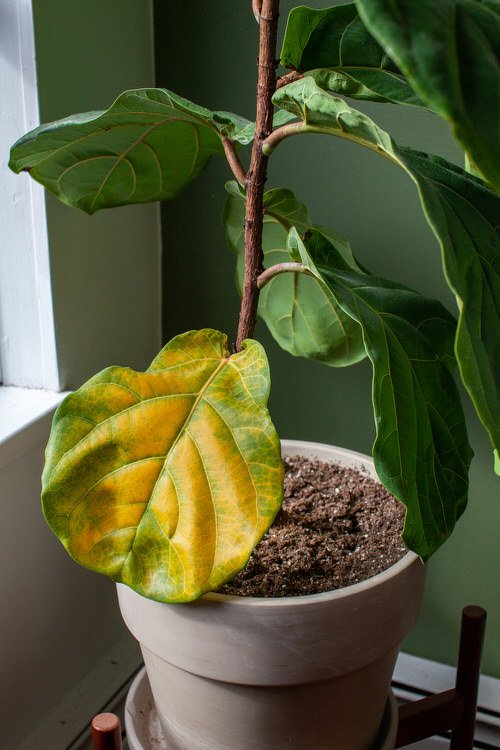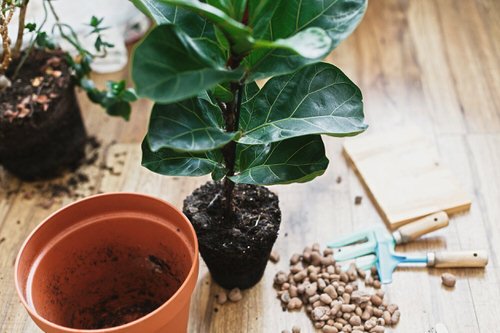Fiddle Leaf Fig Care is tricky but not difficult. Learn everything in detail about How to Grow Fiddle Leaf Fig Tree in this informative article!

Fiddle Leaf Fig is well suited for growing indoors and in gardens because it does not become excessively large. Fiddle leaf fig care and growing is simple if you fulfill a few basic requirements, which you’ll read in this article!
USDA Zones: 10 – 11 (Can be grown indoors in cooler zones)
Difficulty: Easy
Botanical Name: Ficus lyrata
Have a look at the best Fiddle Leaf Fig decoration ideas here
Fiddle Leaf Fig Plant Profile
Fiddle leaf is native to the tropical areas of East Asia, where it grows tall (up to 40 feet), but the size can easily be reduced and kept under control (up to 4-6 feet) when grown in pots as a houseplant.
The foliage of the plant is large, glossy, leathery, dark in color, and furrowed with yellow veins.
Find out secret tips for the healthiest fiddle leaf figs here.
Propagating Fiddle Leaf Fig
Propagating fiddle leaf fig is easy from cuttings in the spring. You can also buy a potted plant from a nursery and multiply it.
Requirements for Growing Fiddle Leaf Fig

Location
Fiddle leaf fig prefers plenty of bright, filtered light when grown as a houseplant. Rotate your plant every month, when you find the plant is reaching for the light. Also, save the plant from the long exposure to the harsh afternoon sun.
Clean the leaves once a week for keeping the foliage free from dust, it will help the plant to soak more sunlight.
Soil
The plant does best in a well-draining soil rich in organic matter. For best growth, use a mix with equal parts of peat moss/coco coir and perlite, along with 2 parts organic soil.
Watering
Water the plant when the top one or two inches of the soil has dried out, use room temperature or lukewarm water as cold water can shock the roots. The plant likes thorough watering but hates to sit in water.
Also, remember that if the foliage turns brown along the margins, then it’s a sign of underwatering. When overwatered, the plant shows off brown spots, edges, and the leaves become soft.
Temperature and Humidity
Fiddle leaf fig likes humid, warm climate with 65-80 F (15-26 C) temperature indoors. Avoid keeping it in a room below 50 F as it will develop brown spots on the leaves.
To boost humidity, keep the plant on a pebble tray filled with water. However, it will do just fine in a low humid area, too.
Note: The plant is sensitive towards drafts. Keep the windows closed, and do not place the fiddle leaf fig near air-conditioning units.
Shake the Trunk
Shaking the tree, 2-3 times a week strengthens the trunk as it imitates the wind. Outdoor fiddle leaf fig gets stronger with the wind, and you can mimic the same through wiggling.
Have a look at the best Tips for Healthiest Fiddle Leaf Figs here
Fiddle Leaf Fig Care
Fertilizer
Fertilize once a month with a water-soluble houseplant fertilizer with a 3-1-2 NPK ratio. Do refer to the label for dosage and instructions. Avoid feeding when it is not in active growth, usually in winter.
Repotting
Repot the plant when roots begin to come out from the bottom of the pot, transfer the fiddle leaf fig to a larger home or trim the root ball. Avoid trimming more than 20 percent of its roots.
Pruning
Remove any damaged or overgrown leaves, crossing branches so the plant can breathe. Make a cut about an inch away from the trunk, gently pull dead brown leaves before trying to cut them.
Pests and Diseases
Small dark or white diffused patches are the signs of pests, which if not eradicated can damage the plant or lead it to death. The most common pests are spider mites, scale, cochineal, and bacterial or fungal diseases.
Along with these, you may see leaf damage like dark patches or spots and small bugs on the foliage. You can treat the problem by using the appropriate fungicide or pesticide. Assure plant has sufficient air-circulation and not sitting in damp surroundings.
Wipe the Foliage
As the leaves of the plant are quite big, they end up attracting dirt that can hinder the plant’s ability to absorb light, affecting photosynthesis. It will be a good idea to wipe the foliage with a damp cotton cloth, once in 2-4 weeks, to keep the leaves clean and shiny!
Common Issues with Fiddle Leaf Fig

Brown Spots
Brown spots or edges occur due to root rot from sitting in water. Examine the roots, if they are mushy and brown. Remove the spotted foliage and cut the mushy portion of the roots. Repot and supervise your watering to ensure the plant is not overwatered.
Extreme temperature swings can also cause brown spots, monitor drafty areas or cooling/heating vents or units, and shift the plant away to a constant warm location.
Bleached Foliage
If you notice light or bleached spots on the top of the foliage, the plant is receiving too much direct sunlight. It is known as leaf scorch or sunburn. Prune the leaf with sharp shears and transfer the plant away from harsh or direct sun.
Yellow Leaves
If a new fiddle leaf fig plant shows off yellow foliage, it’s due to the bacterial issue. Remove the affected foliage and repot in fresh soil.
Dropping Foliage
It happens due to over or under-watering. Also, extreme temperatures can cause leaf drops. Keep the plant away from air-conditioning or heating units. Avoid soggy soil but keep it moist.
Fiddle Leaf Fig Toxicity
If ingested, the plant can cause stomach irritation to pets. It will be a good idea to keep your dogs, cats, and kids away from it.




Help ! I have dark patches on my fiddle fig if it is pest what can I do?
I understand this is a sign of over watering. Let soil completely dry out before watering, and let it go a couple weeks or more with dry soil. Mist with water daily for humidity it desires.
A friend wants to give us a Fiddle Leaf Fig . He has had it 23 years and it has never been trimmed and is growing into his blinds and windows . His wife passed away 20 years ago and has only watered it since then. It is covering two big windows and is up to the ceiling and growing downward . It is root bound for sure.Can we trim it so we can get it out of the house? How far can we trim it back? Also can we put it on our patio?
Thank you